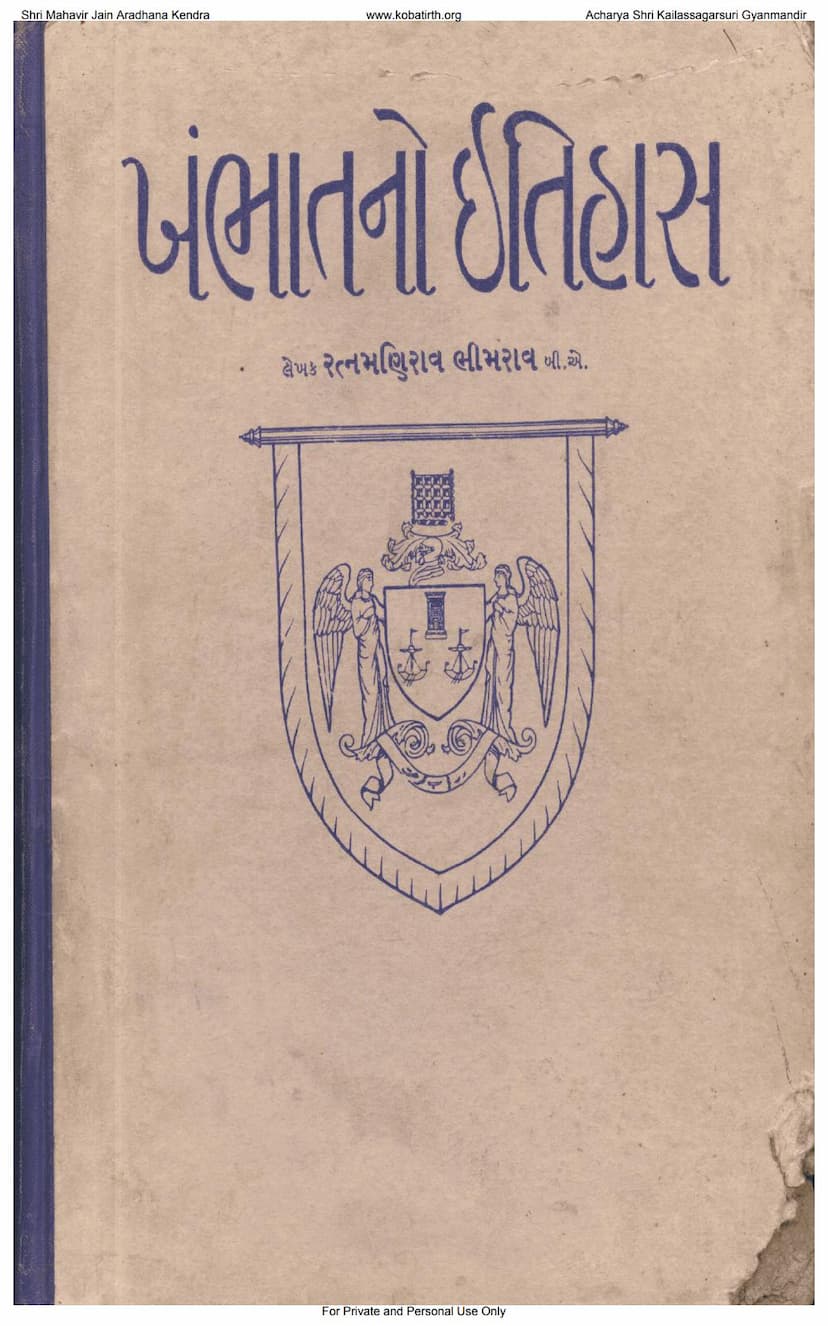Khambhatno Itihas
Added to library: September 2, 2025

Summary
Based on the provided scanned pages, here's a comprehensive summary of "Khambhatno Itihas" (History of Khambhat) by Ratnamanirao Bhimrao, focusing on the key aspects covered in these initial pages:
Book Overview:
- Title: Khambhatno Itihas (The History of Khambhat)
- Author: Ratnamanirao Bhimrao, B.A. (also known as Ratnamannirav Jotye B.A., author of "Gujaratnu Patnagar Ahmedabad")
- Publisher: Dilavarjung Nawab Mirza
- Publication Details: First Edition, 1000 copies. Published in Hijri Year 1354, Samvat 1991, corresponding to AD 1935.
- Patronage: Published under the orders of His Highness Najmuddaula Mumtaz-ul-Mulk Momin Khan Bahadur Dilavarjang Nawab Mirza Hussein Yavar Khan Bahadur of Khambhat.
- Acknowledgement: The Gujarat Sahitya Sabha expresses gratitude to Nawab Saheb for commissioning this work, recognizing Khambhat's historical significance. They also thank the acting Dewan, Purshottam Jogibhai Bhatt, and former Dewan, Diwan Bahadur Narmadashankar Morkar, for their support.
Key Themes and Content Covered in the Scanned Pages:
The initial pages of "Khambhatno Itihas" set the stage for a comprehensive historical and geographical exploration of Khambhat. The text emphasizes the importance of history, particularly for the Gujarati society, which is described as being heavily focused on commercial pursuits.
-
Introduction and Purpose: The author, Ratnamanirao Bhimrao, highlights the significance of studying history, not just for its own sake, but for the cultural enrichment of society. He notes the initial skepticism about the value of historical research in a profit-driven era, but argues for its importance in understanding a nation's progress and identity. The book is presented as a step towards fulfilling Gujarat Sahitya Sabha's mission of documenting the history of historically significant cities.
-
Khambhat's Historical Significance: Khambhat is presented as a city of immense historical importance in Gujarat and India, particularly for its strategic location and its role as a major port. The book aims to chronicle its journey through various eras.
-
Royal Patronage: The undertaking of this historical record was initiated by the Nawab of Khambhat, demonstrating a commitment to preserving the region's legacy.
-
Structure and Content (Table of Contents Preview): The detailed Table of Contents (Anukramanika) reveals the vast scope of the book. It is divided into numerous chapters and appendices covering:
- General Description: Geography, rivers (Mahi, Sabarmati), Gulf of Khambhat, desert areas.
- Mythological and Geographical History: Discussing ancient traditions and geographical interpretations related to Khambhat.
- Nomenclature (Abhidhan): Extensive exploration of the various names associated with Khambhat throughout history, including the connection to "Stambhatirtha" and "Stambhanpur."
- Mythological Era: Discussing myths and legends related to Khambhat, including its connection to the Devasura Sangram (War between Gods and Demons).
- Medieval Hindu Period: Khambhat's role as a port, descriptions by Arab travelers, the Solanki period, Parsi interactions, and rulers like Kumarpal.
- Muslim Period: Khambhat's prominence as a major port during the Sultanate and Mughal eras, its rise and fall, interactions with the Portuguese, and its status under various rulers like Akbar.
- Mughal Era: Detailed accounts of Khambhat during the reigns of Jahangir, Shah Jahan, and Aurangzeb, including descriptions by European travelers.
- Establishment of Independent State: The founding of the Khambhat state, Maratha incursions, and the roles of figures like Momin Khan.
- Trade and Maritime Activities: A comprehensive analysis of Khambhat's trade history, its exports and imports, and its significance in ancient Indian maritime history.
- Industry and Employment: Focus on industries like agate work, textiles, salt, etc.
- Administration: Details on administrative systems during different historical periods.
- Social Development and Education: Insights into the social fabric and educational progress.
- Places of Interest: Description of important landmarks, mosques, palaces, temples, and other sites.
- Appendices: Several appendices delve into specific topics like the etymology of "Khambhat," the Saraswati river's course, Asura tribes, Patal, and lineage of Khambhat's royal family, along with epigraphic and bibliographic data.
-
Early Chapters' Focus:
- Chapter 1 (General Description): Introduces Khambhat's geographical location, its relation to rivers like Mahi and Sabarmati, and the challenges in defining its exact historical boundaries. It mentions the Gulf of Khambhat and the desert region.
- Chapter 2 (Kumari Kshetra and Mythological Geography): Explores the Puranic concept of "Kumari Kshetra" and its potential connection to Khambhat, discussing India's nine island divisions and the significance of Bharatvarsha as a central landmass. It also delves into the ancient origins of the Mahi river.
- Chapter 3 (Abhidhan - Nomenclature): This chapter is dedicated to the names associated with Khambhat, including discussions about "Gajni," "Gambhota," and the argument that Khambhat was not originally a significant Jain pilgrimage site, despite later associations with "Stambhatirtha" and "Stambhanpur." It also touches upon other names like "Tamralipta" and "Mahalipur."
- Chapter 4 (Mythological Era): Argues that Puranic narratives are not mere stories but hold historical truths, discussing events like the Taraka Asura war and Khambhat's association with Pasupata Shaivism.
-
Emphasis on Rigorous Research: The author acknowledges the difficulty in pinpointing precise ancient conditions due to the loss of evidence but aims to use available sources cautiously. He draws upon literary and archaeological findings, comparing them to discoveries like Mohenjo-daro. The text highlights the importance of re-examining old beliefs based on new evidence.
-
Scholarly Collaboration: The author references the contributions of eminent Gujarati scholars like Narsinhrao Bhai, Tansukram Bhai, and C.D. Dalal, indicating a foundation of existing research. He also mentions the involvement of artists like Ravishankar Raval for illustrations.
In essence, "Khambhatno Itihas" is presented as a meticulous and expansive historical work, aiming to cover the multifaceted history of Khambhat from its mythological origins to its medieval and Mughal periods, with a particular focus on its role as a vital port and economic hub. The scanned pages demonstrate a deep dive into geography, mythology, nomenclature, and early historical periods, laying the groundwork for the subsequent detailed historical accounts.